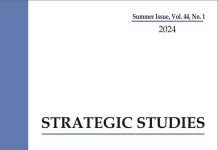Abstract
Today, vital social infrastructures — electricity, finance, water, transportation, health and food — are increasingly dependent on the Information and Communication Technology (ICT) networks for functioning, distribution and interconnectedness. This dependence results in both opportunities and vulnerabilities, which can be exploited by a variety of actors ranging from individuals to organisations and governments. This indicates that information revolution, experienced by the contemporary world, is both a boon and bane. To a large extent, it is a bane because the ICT has an ‘enabling function’ for disruption, crime and state-level aggression. The ICT dependence may become more prone to vulnerabilities in the times of social unrest, political tensions and other appalling events. At present, Pakistan experiences a fast growing application of the ICT in different sectors but seriously lacks in cyber readiness. In addition, the country confronts a hostile security environment internally as well as externally. These factors expose it to various cyber threats. Drawing on the securitisation theory, this paper attempts to examine the cyber threat landscape of Pakistan and focuses on the cyber threats that the country faces across the spectrum — hacking, serious and organised cybercrime, cyberterrorism and cyberwarfare. This is followed by an evaluation of Pakistan’s cyber readiness profile in the light of the five-pillar criteria laid down by the UN specialised agency the International Telecommunication Union (ITU), namely legal, technical, organisational, capacity building and international cooperation.













